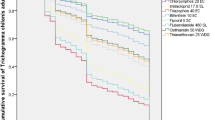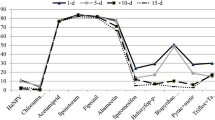Abstract
The effect of 9 insecticides recommended for the control of cotton bollworms was studied, under laboratory conditions, on the emergence ofTrichogramma brasiliensis Ashmead from the parasitized eggs ofCorcyra cephalonica (Stainton) of different age groups. The insecticide concentrations tested were equivalent to those recommended for field application viz. phenthoate 0.14%, phosalone 0.15%, endosulfan 0.25%, permethrin 0.014%, monocrotophos 0.13%, fenvalerate 0.014%, cypermethrin 0.014%, fenitrothion 0.30% and quinalphos 0.14%, quinalphos and fenitrothion caused complete inhibition of emergence of the parasitoid from parasitized host eggs of all ages (1 to 7 days); but in general, adverse effect of insecticides on the disruption of emergence decreased with the advancement in the age of the parasitized eggs. For 1 day old parasitized host eggs, emergence ofT. brasiliensis adults varied from 33 to 57% for the remaining 7 treatments. For the 7 days old parasitized host eggs, emergence of parasitoids from the treatments with endosulfan, phosalone and phenthoate was similar to that from control. However, 46 to 59% inhibition of emergence was observed for permethrin, monocrotophos and cypermethrin. Fenvalerate treatment also significantly inhibited the emergence but at a comparatively lower level (40%). Out of 9 insecticides tested, phosalone and fenvalerate were considered to be relatively safe toT. brasiliensis.
Résumé
L'effet de 9 insecticides recommandés dans la lutte contre les vers de la capsule du cotonnier a été étudié en laboratoire sur l'émergence deTrichogramma brasiliensis Ashmead des œufs parasités deCorcyra cephalonica d'âges variés. Les concentrations testées étaient identiques à celles préconisées dans la pratique (phenthoate 0.14%, phosalone 0,15%, endosulfan 0,25%, perméthrine 0,014% monocrotophos 0,13%, fenvalerate 0,014%, cypermethrine 0,014%, fenitrothion 0,30% et quinalphos 0,14%. Le quinalphos et le fenitrothion inhibaient totalement l'émergence du parasitoïde quel que soit l'âge des œufs hôtes parasités. Mais en général l'action des insecticides sur l'émergence décroissait avec le vieillissement des œufs parasités. Pour des œufs hôtes parasités âgés d'un jour, le pourcentage d'émergence deT. brasiliensis varie de 33 à 57 p. 100 pour les 7 produits restants. Pour des œufs-hôtes parasités âgés de 7 jours, il n'y a pas de différence entre les témoins et ceux traités par l'endosulfan, la phosalone et le phenthoate. Cependant, 46 à 59 p. 100 des œufs traités par la perméthrine, le monocrotophos et la cyperméthrine ne donnent lieu à aucune émergence. Le traitement au fenvalerate supprime aussi d'une manière significative l'émergence, mais comparativement à un niveau plus bas (40 p. 100). Des 9 insecticides essayés, la phosalone et le fenvalerate ont été considérés comme relativement sans effet vis-à-vis deT. brasiliensis.
Similar content being viewed by others
References
Anonymous. — 1983. Annual Report of All India Coordinated Research Project on Biological Control of Crop Pests & Weeds. —Ind. Inst. Hort. Res., Bangalore, India, Section PAU, 1–4.
Anonymous. — 1985. Package of Practises for Kharif Crops. —Punjab Agric. Uni., Ludhiana, India, 46–57.
Bull, D. L. &House, V. S. — 1983. Effect of different insecticides on parasitism of host eggs byTrichogramma pretiosum Riley. —Southwest. Entomol., 8, 46–53.
Kakkar, A. K. — 1981. Pesticide Market for Cotton in Punjab-Farmer's viewpoint.M. Sc. Thesis Punjab Agric. Uni., Ludhiana, India, 60 pp.
Navarajanpaul, A. V., Mohanasundram, M. &Subramanian, T. R. — 1976. Effect of insecticides on the survival and emergence of egg parasite,Trichogramma spp. —Madras Agric. J., 63, 557–560.
Sailer, R. I. — 1981. Extent of biological and cultural control of insect pests of crops.In: CRC Handbook of Pest Management in Agriculture Volume II (D. Pimentel, ed.) —CRC Press Inc., Florida, 57–67.
Singh, P. P. &Varma, G. C. — 1986. Comparative toxicities of some insecticides toChrysoperla carnea [Chrysopidae: Neuroptera] andTrichogramma brasiliensis [Trichogrammatidae: Hymenoptera], two arthropod natural enemies of cotton pests. —Agric. Ecosystems Environ., 15, 23–30.
Singh, S. P. — 1986. Relative toxicities of pesticides to predators and parasites. —Natn. Conf. Short term & Long term Hazards of Pesticides & Strategies for their Safe Use, February 26–28, 1986, New Delhi.
Snedecor, G. W. &Cochran, W. G. — 1976. Statistical Methods. —Oxford & IBH Publishing Company, New Delhi, 369–375.
Stevenson, J. H. &Walters, J. H. H. — 1983. Evaluation of pesticides for use with biological control. —Agric. Ecosystems Environ., 10, 201–215.
Tipping, P. W. &Burbutis, P. P. — 1983. Some effects of pesticide residues onTrichogramma nubilale [Hymenoptera: Trichogrammatidae]. —J. Econ. Entomol., 76, 892–896.
Ulbricht, T. — 1983. Biological control and the future of agriculture. —Agric. Ecosystems Environ. 10, 99–100.
Varma, G. C., Maninder, &Singh, B. — 1978. The growth of population ofTrichogramma brasiliensis Ashmead. —J. Entomol. Res., 2, 209–211.
Author information
Authors and Affiliations
Rights and permissions
About this article
Cite this article
Varma, G.C., Singh, P.P. Effect of insecticides on the emergence ofTrichogramma Brasiliensis [Hymenoptera: Trichogrammatidae] from parasitized host eggs. Entomophaga 32, 443–448 (1987). https://doi.org/10.1007/BF02373512
Received:
Accepted:
Issue Date:
DOI: https://doi.org/10.1007/BF02373512
Key-Words
- Trichogramma brasiliensis
- cypermethrin
- endosulfan
- fenitrothion
- monocrotophos
- permethrin
- phenthoate
- phosalone
- quinalphos




